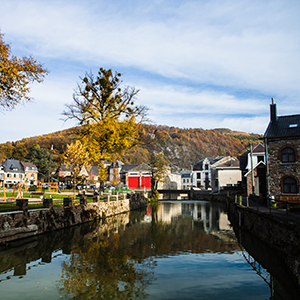Dorinne
Introduction
 The village of Dorinne lies between the Ry d'Août and Bocq valleys, on the south-facing slopes.
The village of Dorinne lies between the Ry d'Août and Bocq valleys, on the south-facing slopes.
The old centre is half-way up the slope, centred around 2 large farms, dating back to the 17th and 18th centuries (but which have been extensively altered since then).
The housing is thinly spread along the sloping roads and on the crest, with 19th-century houses and small farms.
Along the Bocq, there are a large number of old quarries where limestone and sandstone was extracted.
History and Heritage
Dorinne is thought to come from the Celtic word "durom" meaning "fortlet". This village lies on a Roman road which has left its mark on the local place names (chinstrée, chinvoye).
In 1023 the name was written "Duros" and later Dorina, Durines, Dorine and Dorinne. The site of Dorinne was occupied by the Romans and later by the Franks.
For centuries, Dorinne comprised 2 rural communities: part of the territory of Dorinne was simply a dependency of the Spontin estate (land belonging to the King) which was part of the provostship of Poilvache, in the County of Namur.
The other eastern and central part of Dorinne corresponded to the parish and was one of the 32 wards making up the borough of Ciney, under the jurisdiction of the Feudal Court of Liege (Liege region). This land was thenceforth a Liege enclave in Namur territory. The lords of the Dorinne estate are known back to 1313; they belonged to the Fontaine (1313), Dorinne (1400), Brant (1460), Salmier (1591) and Glymes de Brabant families until the Revolution.
This separation remained in place after the Revolution. The Liege part formed the municipality of Dorinne and the part joined onto Spontin simply remained a part of that municipality. However, in December 1821, the 2 sections were brought together to form a single entity.
The economic life of the village was dominated by farming. From the turn of the century, the area of farmed land has decreased in favour of more grasslands due to more intense sheep and cattle farming. During the last century, the traditional rural trades were well represented but these have gradually disappeared. Only the Dorinne stone quarries (which employed around 100 workers in 1937) now represent the industrial sector.



